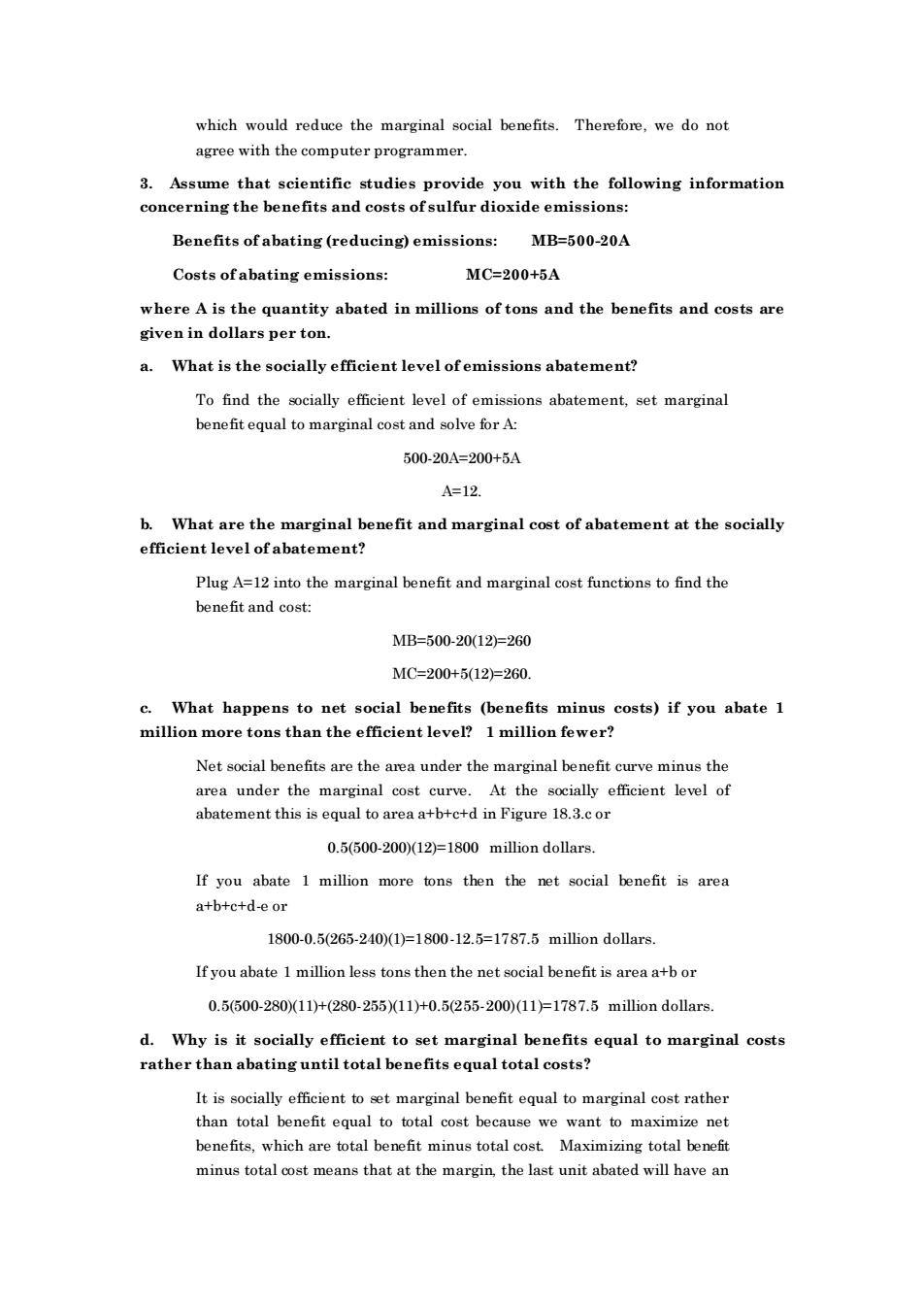正在加载图片...

which would reduce the marginal social benefits.Therefore,we do not agree with the computer programmer. 3.Assume that scientifie studies provide you with the following information concerning the benefits and costs ofsulfur dioxide emissions: Benefits of abating(reducing)emissions: MB=500-20A Costs ofabating emissions MC=200+5A where A is the quantity abated in millions of tons and the benefits and costs are given in dollars per ton. a.What is the socially efficient level ofemissions abatement? To find the socially efficient level of emissions abatement,set marginal benefit equal to marginal cost and solve for A: 500-20A=200+5A A=12 b.What are the marginal benefit and marginal cost of abatement at the socially efficient level of abatement? Plug A=12 into the marginal benefit and marginal cost functions to find the benefit and cost: MB=50020(12260 MC=200+5(12260. c.What happens to net social benefits (benefits minus costs)if you abate 1 million more tons than the efficient level?1 million fewer? Net social benefits are the area under the marginal benefit curve minus the area under the marginal cost curve.At the socially efficient level of abatement this is equal to area a+b+c+d in Figure 18.3.cor 0.(500-200)(12)=1800 million dollars If you abate 1 million more tons then the net social benefit is are a+b+c+d-e or 1800-0.5(265-2401=1800-12.5=1787.5 million dollars. If you abate 1 million less tons then the net social benefit is area a+bor 0.5600-28011)+(280-25511)+0.5255-200)(111787.5 million dollars d.Why is it socially efficient to set marginal benefits equal to marginal costs rather than abating until total benefits equal total costs? It is socially efficient to set marginal benefit equal to marginal cost rather than total benefit equal to total cost because we want to maximize net benefits.which are total benefit minus total cost Maximizing total benefit minus total co means that at the margin,the last unit abated will have anwhich would reduce the marginal social benefits. Therefore, we do not agree with the computer programmer. 3. Assume that scientific studies provide you with the following information concerning the benefits and costs of sulfur dioxide emissions: Benefits of abating (reducing) emissions: MB=500-20A Costs of abating emissions: MC=200+5A where A is the quantity abated in millions of tons and the benefits and costs are given in dollars per ton. a. What is the socially efficient level of emissions abatement? To find the socially efficient level of emissions abatement, set marginal benefit equal to marginal cost and solve for A: 500-20A=200+5A A=12. b. What are the marginal benefit and marginal cost of abatement at the socially efficient level of abatement? Plug A=12 into the marginal benefit and marginal cost functions to find the benefit and cost: MB=500-20(12)=260 MC=200+5(12)=260. c. What happens to net social benefits (benefits minus costs) if you abate 1 million more tons than the efficient level? 1 million fewer? Net social benefits are the area under the marginal benefit curve minus the area under the marginal cost curve. At the socially efficient level of abatement this is equal to area a+b+c+d in Figure 18.3.c or 0.5(500-200)(12)=1800 million dollars. If you abate 1 million more tons then the net social benefit is area a+b+c+d-e or 1800-0.5(265-240)(1)=1800-12.5=1787.5 million dollars. If you abate 1 million less tons then the net social benefit is area a+b or 0.5(500-280)(11)+(280-255)(11)+0.5(255-200)(11)=1787.5 million dollars. d. Why is it socially efficient to set marginal benefits equal to marginal costs rather than abating until total benefits equal total costs? It is socially efficient to set marginal benefit equal to marginal cost rather than total benefit equal to total cost because we want to maximize net benefits, which are total benefit minus total cost. Maximizing total benefit minus total cost means that at the margin, the last unit abated will have an